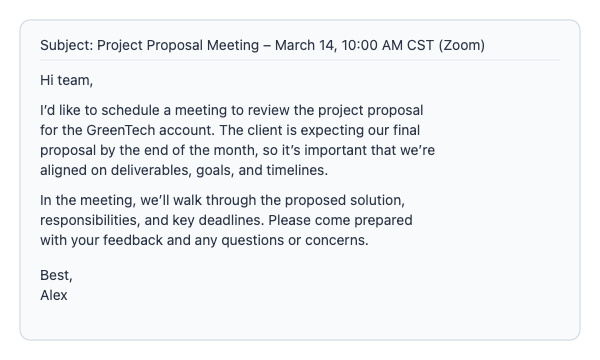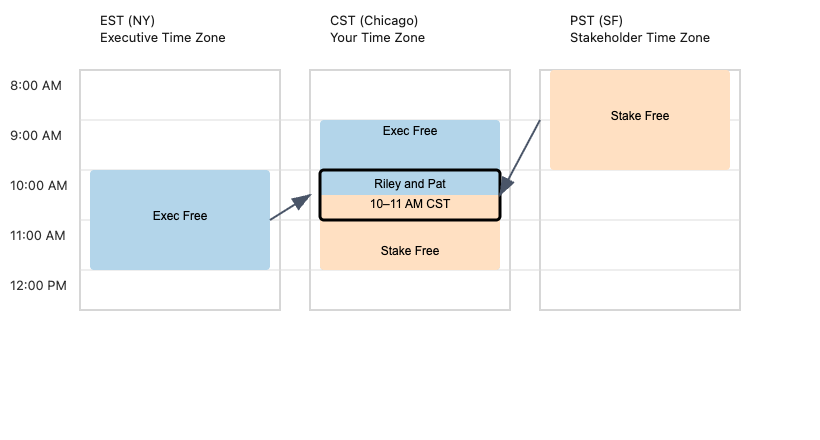Welcome to your journey in Driving Meeting Success as an Executive Assistant.
Coordinating meetings might sound pretty straightforward, but as an executive assistant, your job is much more dynamic. You’re the person who keeps everyone connected and in sync, whether your executive is down the hall or halfway around the world! Meetings are where big decisions happen, strategies take shape, and relationships grow, so your knack for bringing people together is essential to your executive’s success and the whole organization.
In this course, you’ll step into the full meeting lifecycle from an executive assistant’s perspective. You’ll see that your role is about much more than just sending out calendar invites. You’ll learn how to:
- Coordinate meetings across time zones for multiple stakeholders, ensuring everyone can participate no matter where they are in the world.
- Facilitate meetings efficiently by providing real-time support, anticipating needs, and troubleshooting issues as they arise.
- Communicate scheduling constraints and meeting conflicts with empathy, so all parties feel respected and informed.
- Follow up on meetings with stakeholders to ensure clarity, confirm next steps, and gain valuable feedback
You’ll explore practical strategies, real-world examples, and hands-on exercises designed to build your confidence and skill. By the end, you'll be ready to support executives and teams with confidence, even in the most demanding environments!
Scheduling a meeting can feel as simple as making lunch plans with a friend — you check when you’re both free, pick a time, and meet up. But as an executive assistant, you’re often coordinating with people in different cities, sometimes across the country, or even globally! Imagine trying to set up a call between someone in New York and someone in San Francisco. Now, you’re not just comparing calendars, but you’re also juggling time zones.
When you’re the one scheduling, it’s often easiest to convert everyone’s availability into your own time zone. That way, you’re comparing apples to apples.
For example, let’s say you’re based in Chicago (CST). Your executive in New York (EST) is available at 10:00 AM their time, and a stakeholder in San Francisco (PST) is free from 8:00 AM - 10:00 AM their time. Instead of trying to juggle three different clocks, just convert both times into CST:
- 10:00 AM EST is 9:00 AM CST (Since EST is one hour ahead of CST)
- 8:00 AM PST is 10:00 AM CST (Since PST is two hours behind CST)
- 10:00 AM PST is 12:00 PM CST
Now, looking at your own calendar in CST, you see that 10:00 AM CST might be a viable time for the executive to meet with the stakeholder. But since it isn't quite showing availability for everyone, it's best to have a conversation with the executive.
Here’s how that conversation might play out when you’re working through time zones and keeping everyone in the loop:
- Jake: Hi Victoria, I’m looking to schedule a project proposal meeting on the GreenTech account with you and the stakeholders. I see you’re available at 11:00 AM EST, and one of our stakeholders in San Francisco is only free from 8:00 AM to 10:00 AM PST.
- Victoria: Thanks for checking, Jake! So 10:00 AM CST would work for everyone, right?
- Jake: Exactly! If we set the meeting for 10:00 AM CST, it lines up for all of you. Does that time suit you?
- Victoria: Yes, that works. Please send the invite with all the details.
- Jake: Will do. And if anything changes, I’ll let everyone know as soon as possible and suggest alternative times.
- Victoria: Appreciate your flexibility, Jake. Thanks for keeping everyone in the loop.
In this exchange, Jake is doing exactly what you’d want as an executive assistant—he checks everyone’s availability across time zones, double-checks the conversions, and keeps his communication clear and specific. He also lets Victoria know he’ll keep her updated if anything changes. By being upfront and organized, he makes the whole process run smoothly and helps everyone feel confident about the plan.
Once you’ve found a time that works, the next step is to make sure everyone’s on the same page. Think of it like making plans with friends. You wouldn’t just say, “Let’s meet sometime next week.” Instead, you’d send a quick message with the exact time, place, and what you’re meeting about. It’s the same when you’re scheduling for executives.
Send out a calendar invite and a follow-up email that spells out all the details:
- What the meeting is about
- When the meeting will be (with the time zone)
- Where you’ll meet (in person or virtually)
For example, a clear subject line could be: “Project Proposal Meeting – Thursday, March 14, 10:00 AM CST (Zoom).” In the message body, add a note about what will be discussed so everyone knows what to expect and can come prepared.
When creating meeting invites, it is important to answer the what, when, where, and why so people will be more willing and able to come. The first 3 should go in the subject line — this will capture the reader's attention right away. The why should always go in the message body. In the example below, you will see the why is to align on the deliverables, goals, and timelines.

Sometimes, plans change and you have to reschedule. When that happens, let everyone know as soon as possible. 📢 Be clear about why the meeting is moving, share the new details, and show you understand it might be inconvenient. For example: “Due to a scheduling conflict, we need to move our project proposal meeting to next Wednesday at 2:00 PM CST. I apologize for any inconvenience and appreciate your flexibility.” This kind of communication shows you’re organized and considerate, and it helps keep everyone feeling respected, even when things shift around.
As you move forward, you’ll get to practice these skills in realistic writing scenarios, where you’ll apply what you’ve learned to real-world scheduling and communication challenges.

